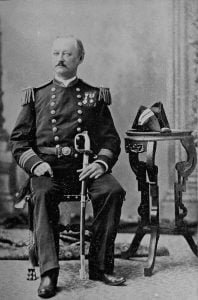
Chief Engineer in the U. S. Navy
The subject of this sketch, Albert Silverman Greene, was born in Adams, Aug. 3, 1838. He attended select school at Adams Seminary, autumns and winters, until 1855. In November, 1855, he entered the “Rensselaer Polytechnic College,” of Troy, N. Y., in advance standing, graduating with the degree of Civil Engineer in June, 1859, number five in a class of twelve graduates, and which had numbered, from the time of his entrance, over one hundred individual members. Among the graduates in the same class were A. J. Cassatt, V. P. Penna. R. R. Co.; Walter Crofts, Supt. Shelby Iron Works, Ala.; G. M. Greene, P. A. Engineer, U. S. Navy; Jas. R. Percy, late Capt. U. S. Engineers; Russell Sage, Supt. Milwaukee & St. Paul R. R.; Frank G. Smith, Maj. 4th U. S. Artillery; L. J. de Vizcarrondo, Chief Engineer Cordova & Malaga R. R., Spain; and N. A. Williams, formerly engineer on the Brooklyn and Croton water-works.
In December, 1859, he received permission to be examined for admission into the engineer corps of the U. S. Navy; passed the examination successfully, and was admitted as number ten in a class of sixty-three who were examined. In the first competitive examination for pro-motion he was advanced to the head of his class, which position has been maintained through all the subsequent grades up to the present time.
His first cruise was made in the U. S. steamer “Susquehanna,” in 1860-61, on the coast of Mexico, the Mediterranean, and on the home station in the early part of the late war. In the latter part of 1861 he was detached from the “Susquehanna” and ordered to duty in the Navy Department, Washington, D. C, where he remained until the early part of 1868. He was then ordered on a cruise in the U. S. S. “Nyack” to the South Pacific station, which continued until 1871. He was then detached, and after-wards served on board the iron-clad “Mahopac,” U. S. S. “Nantasket;’ and U. S. S ”Nipsio,” on the home and West India stations. In 1873 he was ordered to duty on the board for the examination of naval officers for promotion, and later as a member of the U. S. commission to investigate the causes of steam-boiler explosions, at the same time superintending government work in process of construction at Newburgh, N. Y. On the completion of this duty, in July, 1874, he was ordered to the U. S. S. “Benicia,” North Pacific station, and in 1875 transferred to the U. S. S. “Lackawanna,” same station, from which he was detached in August last, and in October following was ordered as a member of the board to examine officers for promotion, which duty he is now engaged in.
Source: Durant, Samuel W. and Henry B. Peirce. History of Jefferson County, New York, With Illustrations and Biographical Sketches of Some of its Prominent Men and Pioneers. Philadelphia: L.H. Everts & Co., 1878. p 263-264.
